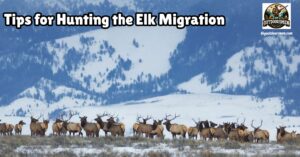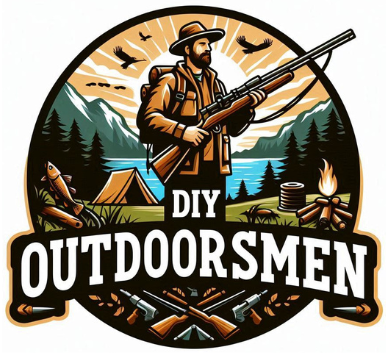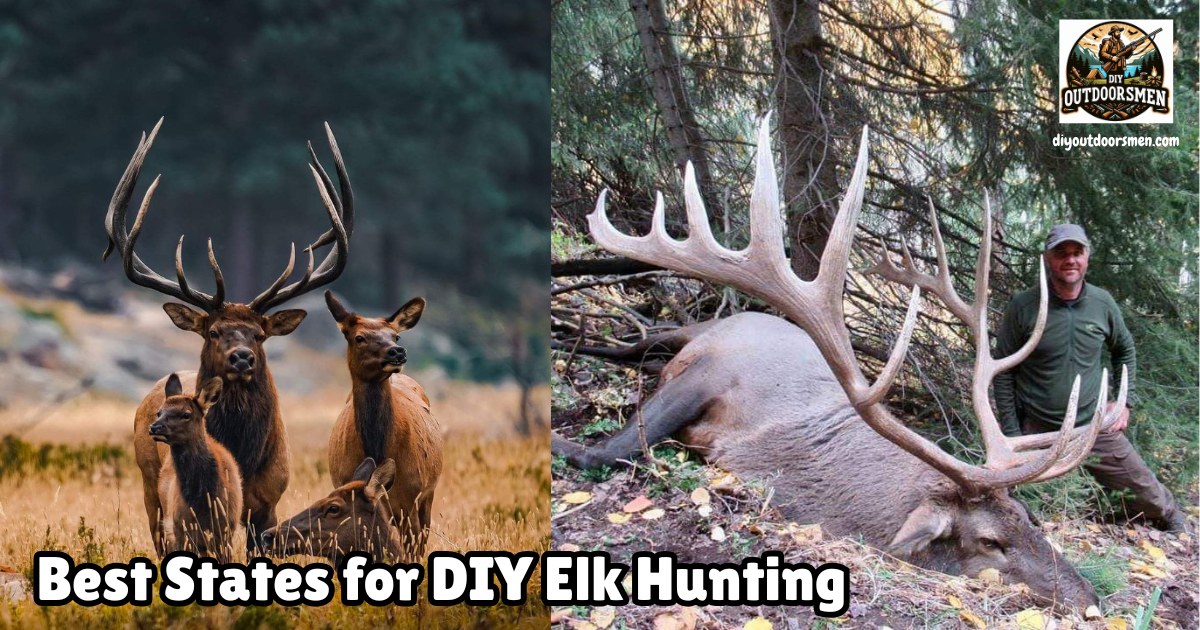Contents
- 1 1. Know State Regulations: Follow Local Requirements
- 2 2. Understand Season Timings and Weather Patterns
- 3 3. Choosing Your State: Top Performers for DIY Elk Hunting
- 4 4. Gear and Equipment: Preparing an All-in-One Checklist
- 5 5. Scouting and Navigation: Mapping Out Your Hunt
- 6 6. Land Access: Public Versus Private Hunting Grounds
- 7 7. Navigating Permit Applications and Licensing
- 8 8. Budget Planning: Managing Costs for a DIY Hunt
- 9 9. Emphasizing Safety and Survival Skills
- 10 10. Reflecting on Your Experience: Post-Hunt Follow-Up and Improvement
- 11 Final Thoughts On Best DIY Elk Hunting States
Elk hunting can be a rewarding outdoor adventure, especially when you plan the hunt on your own. DIY elk hunting allows me to experience nature at its finest and learn more about the landscapes and wildlife. It also gives the chance to plan a budget-friendly and personalized excursion in states known for their abundant elk populations.
QUICK LOOK: 8 Steps to Finding the Best DIY Elk Hunting States
- Know State Regulations: I always begin with a careful review of a state’s hunting regulations. Some states have unique license procedures or even draw-based permits. Knowing these details can save time and reduce frustration when planning your hunt.
- Understand Season Timings and Weather Patterns: Season timing is a key factor in planning your elk hunt. Different states call their hunting seasons at different times, so keeping a close eye on both legal seasons and the natural migration patterns of elk is essential.
- Top Performers for DIY Elk Hunting: Some states naturally offer better conditions for the DIY hunter. I have often focused on states known for both plentiful elk populations and manageable regulations.
- Gear and Equipment Required: Having the right equipment is a fundamental element of any DIY elk hunt. I take time to compile an all-in-one checklist before my trip. Not only does this boost confidence, but it also minimizes potential setbacks in the field.
- Scouting and Navigation: Understanding the terrain is a central part of DIY elk hunting. I spend time scouting the area and using mapping tools to identify prime elk habitats and areas that might be more challenging to reach.
- Land Access: Access to land is a topic that every DIY hunter must consider. Whether you choose to hunt on public lands, private properties, or a mix of both depends on state laws as well as personal preference.
- Permit Applications and Licensing: The process of obtaining permits and licenses can initially seem confusing. Each state has its own system for managing hunting permits, and understanding these systems in advance can save you both time and headaches.
- Managing Costs for a DIY Hunt: Budgeting is a very important part of planning any self-guided elk hunt. DIY elk hunting can often save money, though there are essential costs that must be factored in.
If you have a passion for the great outdoors and want to take control of your elk hunting experience, researching which states offer the best conditions is very important. A careful study of local regulations, terrain, and seasons can make the difference between a successful hunt and one filled with unexpected hurdles. This article explores practical tips and guidance to help you choose and get the most from the best DIY elk hunting states.
Over the years, I have spent plenty of time studying different regions known for their elk hunting opportunities. In what follows, I share the insights that have helped shape my own hunting experiences. The tips here are straightforward and clear, designed to make self-guided hunts more accessible and enjoyable for anyone willing to put in the effort.
1. Know State Regulations: Follow Local Requirements
Before heading out, it is very important to understand that elk hunting rules vary widely. I always begin with a careful review of a state’s hunting regulations. Some states have unique license procedures or even draw-based permits. Knowing these details can save time and reduce frustration when planning your hunt.
Here are some ways to get started with state regulation research:
- Visit the official wildlife or natural resources website for the state.
- Check the permit requirements and application deadlines.
- Review any seasonal restrictions or special area rules specific to elk hunting.
This groundwork helps set the stage for a smoother and more enjoyable DIY elk hunting experience. In addition, spending extra time reviewing updates and changes in state policies can be a game-changer. Many local agencies now post frequently updated guidelines that can help you steer through any unexpected adjustments in rules. Taking advantage of online forums and local hunter groups also provides useful insights that you might otherwise miss.
2. Understand Season Timings and Weather Patterns
Season timing is a key factor in planning your elk hunt. Different states call their hunting seasons at different times, so keeping a close eye on both legal seasons and the natural migration patterns of elk is essential. I consider everything from start dates to last-minute weather changes when making my plans.
Learning about local weather trends is also useful. Mountainous regions in particular can experience sudden shifts in weather, and planning around these expectations improves overall safety and comfort. Here are some details to look for:
- Season start and end dates as set by state authorities.
- Weather trends during these periods, including temperature fluctuations and precipitation patterns.
- Regional conditions that may affect elk activity and movement.
Beyond the basic details, I recommend checking historical weather data and local forecasts frequently in the weeks leading up to your hunt. This extra research can step up your preparedness and help you avoid days when conditions might compromise safety. It also allows you to adjust your plans at the last minute if needed.
3. Choosing Your State: Top Performers for DIY Elk Hunting
Some states naturally offer better conditions for the DIY hunter. I have often focused on states known for both plentiful elk populations and manageable regulations. For instance, many states feature diverse landscapes, including high mountain ranges and forested valleys that provide excellent backdrops for a thrilling outdoor excursion.
My personal research highlights several states that consistently yield good opportunities for self-guided hunts. Here are a few pointers to consider:
- States such as Colorado, Montana, and Wyoming are celebrated for their wide-open public lands and clear, straightforward hunting guidelines.
- Regions where elk are naturally abundant and where weather conditions are generally mild, reducing extreme challenges.
- Places with supportive local communities that offer accessible resources for hunting preparation and advice.
This makes it easier to plan a hunt that is both engaging and cost-effective. If you spend time exploring local maps and statistics on elk populations, you can pinpoint locations that not only offer quantity but also quality in terms of safer hunting grounds. Taking this approach gives you more control over your expedition and allows you the flexibility to adjust your plans as needed.
4. Gear and Equipment: Preparing an All-in-One Checklist
Having the right equipment is a fundamental element of any DIY elk hunt. I take time to compile an all-in-one checklist before my trip. Not only does this boost confidence, but it also minimizes potential setbacks in the field. Good gear can be the difference between a smooth outing and a challenging ordeal.
It is helpful to organize your gear into clear categories such as clothing, hunting tools, navigation aids, and camping supplies. Below are some essential items to pack:
- Appropriate clothing layers that protect against variable weather conditions.
- Reliable equipment, including scopes, binoculars, and a quality rifle or bow.
- Navigation tools like a GPS device, detailed trail maps, and a sturdy compass.
- Basic camping and survival gear such as a first aid kit and a multi-tool.
A thorough equipment check is part of planning a stress-free experience. I also recommend rehearsing the use of your gear in a controlled environment before your trip. This extra practice helps ensure that, when the moment comes, your gear performs as expected and you can focus fully on the hunt.
Understanding the terrain is a central part of DIY elk hunting. I spend time scouting the area and using mapping tools to identify prime elk habitats and areas that might be more challenging to reach. This preparation can have a major impact on the outcome of your expedition.
Effective scouting can involve several strategies:
- Study topographic maps to locate ridges, valleys, and water sources that attract elk naturally.
- Make use of digital apps that offer satellite images and terrain analysis to get a clear sense of the land.
- Mark potential hunting spots in advance to design a practical and efficient route.
I also recommend spending some time in the field before the hunt to get a feel for the terrain firsthand. By physically exploring the landscape, you can spot subtle features that a map might not reveal. This extra scouting builds your confidence and sharpens your ability to pinpoint promising locations once the hunt begins.
6. Land Access: Public Versus Private Hunting Grounds
Access to land is a topic that every DIY hunter must consider. Whether you choose to hunt on public lands, private properties, or a mix of both depends on state laws as well as personal preference. I always review local boundaries well in advance to understand where I can legally hunt.
Here are some ideas to help decide:
- Public lands often allow broader access but usually require strict adherence to established guidelines.
- Private lands may require obtaining permission from owners, which means planning for extra communications.
- Some states even offer unique options, like special permits that let you hunt on private property under regulated conditions.
Understanding land access rules not only minimizes surprises but also ensures that your DIY hunt stays within legal boundaries and respects local norms. It is always a good idea to contact local authorities or land managers directly if you have any doubts or questions regarding property restrictions. This approach helps avoid potential conflicts and safeguards the integrity of your hunting experience.
The process of obtaining permits and licenses can initially seem confusing. I always tackle this step with patience and a careful review of all provided guidelines. Each state has its own system for managing hunting permits, and understanding these systems in advance can save you both time and headaches.
Steps to prepare include:
- Read through the state wildlife department’s application process in detail.
- Prepare the necessary documentation well in advance to avoid last-minute hurdles.
- Keep track of application deadlines and any associated fee structures.
This systematic approach to securing permits provides extra peace of mind. I have found that setting aside time each season to handle permit logistics not only speeds things up but also helps you avoid any unexpected delays that might affect your hunting schedule. Once you have navigated the permit process successfully, it instills a sense of accomplishment and readiness for the adventure ahead.
8. Budget Planning: Managing Costs for a DIY Hunt
Budgeting is a very important part of planning any self-guided elk hunt. I find it helpful to outline expenses early on so that the overall experience remains enjoyable and free from financial stress. DIY elk hunting can often save money, though there are essential costs that must be factored in.
The list of potential expenses might include:
- Travel costs, including fuel and accommodations near the hunting areas.
- Permit and licensing fees, which can vary significantly by state.
- Equipment rentals or necessary purchases that add to the overall cost.
By preparing a detailed budget, you can easily pinpoint areas where you might save money and plan for any unforeseen expenditures. I also recommend reviewing past trips and comparing costs so that you have an accurate baseline for future adventures. This careful planning makes sure that your hunt remains both affordable and truly rewarding, leaving you with more funds available for future outings.
9. Emphasizing Safety and Survival Skills
When pursuing a DIY elk hunt, safety always comes first. I take care to polish all essential survival skills and always carry adequate safety equipment. Recognizing potential risks in remote areas is a responsibility that should never be overlooked.
Practical tips for staying safe include:
- Carrying a reliable first aid kit and being well-versed in basic first aid techniques.
- Always share your hunting itinerary with a friend or family member so someone knows your whereabouts.
- Preparing for unexpected weather changes by packing extra clothing and shelter options.
In addition, I make sure to constantly practice emergency procedures, whether through training courses or by reviewing survival guides. This proactive approach ensures that, if an unforeseen situation arises, you are well prepared to handle it. It not only makes the experience safer but also builds confidence, allowing you to focus on the hunt without unnecessary worry.
10. Reflecting on Your Experience: Post-Hunt Follow-Up and Improvement
After a DIY elk hunt, I find it very useful to take some time to reflect on the overall experience. Consider what aspects worked well and what could be improved for future trips. Learning from each expedition plays a vital role in refining your techniques and planning processes.
Ways to conduct a thorough post-hunt review include:
- Reviewing maps and personal notes to determine which areas yielded the best results.
- Analyzing the performance of your equipment and updating your all-in-one checklist accordingly.
- Assessing personal safety measures and planning for improvements in tactics.
This level of reflection not only turns each hunt into an educational opportunity but also helps to better prepare you for future outings. Spending time to carefully size up your performance and tweak your strategy can lead to significant improvements next time you set out into the wilderness. Every hunt provides a chance to refine your approach and ultimately make your self-guided excursions even more successful.
Final Thoughts On Best DIY Elk Hunting States
DIY elk hunting offers a chance to enjoy nature while refining self-reliance and planning skills. By understanding state regulations, preparing your gear properly, scouting areas thoroughly, and prioritizing safety, I have found a rewarding balance between adventure and responsibility.
Each state offers unique challenges and opportunities, and the key to a fulfilling hunt is choosing one that aligns with your personal goals and experience level. Planning your elk hunt with careful attention to detail creates a more fulfilling and stress-free experience.
Taking control of your hunting adventure means continuously learning, adapting to new conditions, and investing in your skills. With every trip, there is a chance to grow as a hunter, build lasting memories in the outdoors, and truly enjoy the ride. Bottom line, when all the details come together, you not only have a hunt—you have an experience that sticks with you for a lifetime.
Check Out These Recent Articles
- 14 Tips And Tactics For Public Land Mule Deer Hunting

- 6 Features of Waterproof Ground Blinds For Wet-condition Elk Hunting

- 4 of the Best DIY Elk Hunting Areas In Colorado

- 8 Tips for Choosing the Best DIY Elk Hunting States

- 5 Hunting Gear Packing List Essentials For DIY Trips

- 7 Tips For Hunting The Elk Migration

As always, stay safe, enjoy the journey, and please try to leave it cleaner than you found it. If you have any comments, questions, ideas, or suggestions, please leave them in the comment section below, and I’ll get back to you ASAP. You can follow us on YouTube: Man Art Creations for videos of our DIY Adventures.
P.S. – Thanks so much for checking out our blog. We really appreciate it. Just so you know, we may receive a commission if you click on some of the links that appear on our site. This helps us keep our content free and up-to-date for everyone. We appreciate your support!



